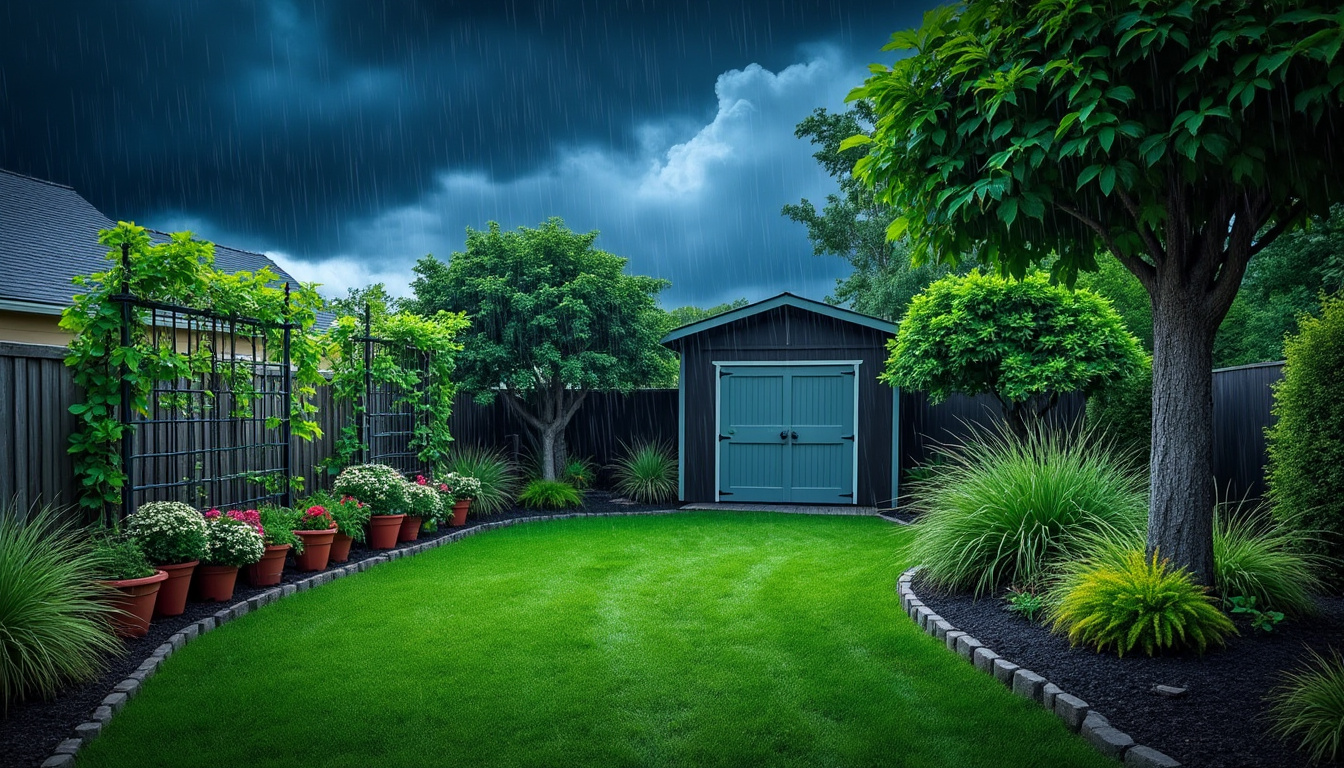Unpredictable weather patterns in recent years have intensified the challenges faced by gardeners, turning what was once a serene hobby into a battle against the elements. From severe downpours and strong winds to unexpected hail and temperature drops, gardens are increasingly vulnerable to storm damage. With weather services predicting ongoing yellow weather warnings and possible snow in some regions, safeguarding outdoor spaces becomes not just prudent but essential. Implementing strategic preparations can mitigate losses and preserve the life and beauty of any garden, whether it’s an urban green retreat, a vegetable patch, or a sprawling countryside layout.
Storms impact gardens through various means: uprooting plants, flooding soil, damaging outdoor furniture, and clogging drainage systems. Each component of a garden requires specific attention and protective measures tailored to withstand adverse conditions. Beyond aesthetic loss, storm damage can have economic consequences, affecting local nurseries, landscapers, and homeowners alike. Leveraging trusted products such as Rain Bird irrigation systems, Fiskars gardening tools, or WeatherGuard protective coverings enhances the resilience of gardens. Equally important is understanding how to implement best practices in storm readiness. This article unpacks essential strategies homeowners and gardening enthusiasts should adopt to effectively shield their gardens against the growing threat of storms.
Securing Outdoor Garden Furniture and Loose Items Before Storms
Outdoor furniture and garden accessories, if not properly secured, can cause trouble during storms. Flying trampolines, overturned barbecues, and scattered garden tools represent hazards to both property and people. Preparing these items not only protects them but also prevents them from becoming dangerous projectiles. This begins with an inventory of all movable and loose items in the garden.
Large furniture such as sofas, tables, and play equipment should be covered with weatherproof tarps that can be tightly secured using ropes or bungee cords. Brands like WeatherGuard offer reliable tarp solutions designed to withstand harsh weather conditions. Smaller items such as garden ornaments, plant pots, and decorative lights benefit from indoor storage — a sturdy shed or garage provides a safe environment away from destructive winds and rain.
Essential steps to secure garden items include:
- Using weather-resistant covers for bulky furniture and equipment
- Storing small gardening accessories and tools indoors during storm season
- Anchoring lightweight structures like greenhouses or cold frames with stakes or weights
- Clearing the garden area of items that could easily be swept away
Taking these precautions before a storm shields furniture from water damage and prevents costly replacements. Additionally, protecting garden infrastructure maintains the aesthetic and functional integrity of outdoor spaces. Detailed, practical guidance on protecting outdoor furniture can be found in specialized resources such as this comprehensive guide.
| Item Type | Recommended Protection | Brands & Tools |
|---|---|---|
| Large Furniture (Sofas, Tables) | Weatherproof tarp, tie-downs, secure anchoring | WeatherGuard Tarps, Master Mark tie-down straps |
| Garden Play Equipment (Trampolines, Swing Sets) | Anchoring stakes, remove if possible | Greenworks Anchors, Fiskars garden stakes |
| Small Items (Pots, Ornaments) | Indoor storage in shed or garage | Standard storage sheds, waterproof containers |
| Garden Tools (Mowers, Hand Tools) | Protective storage, weather-resistant coatings | Fiskars Tools, storage cabinets |
Implementing Effective Plant Protection Techniques To Withstand Storm Conditions
Plants are the heart of any garden, but their delicate nature often makes them susceptible to storm damage. Particularly vulnerable are potted plants and tall or sprawling species that can topple or break in high winds. Proper plant protection strategies can minimize physical harm and improve recovery post-storm.
For movable plants, relocating them indoors or under covered spaces is the simplest defense. However, this is not always feasible with planted-in-ground species, particularly established trees or shrubs. At this stage, physical supports become crucial.
Effective ways to support plants include:
- Installing sturdy wooden or metal stakes and tying plants loosely to these supports
- Using trellises to shield groups of plants and prevent overcrowded damage
- Applying windbreaks—such as temporary fabric screens or native hedge rows—to reduce wind impact
- Covering vulnerable plants with breathable, weather-resistant material to shield from heavy rain and hail
Employing premium gardening brands like Scotts for high-quality stakes and trellises or Miracle-Gro for plant health supplements can strengthen plants’ resilience. Furthermore, consulting guides on rooftop wild gardens (read here) can offer insights into protection methods adapted to limited spaces.
| Protection Technique | Suitable Plant Types | Best Use Cases |
|---|---|---|
| Wooden/Metal Stakes | Tall, single-stemmed plants | Supporting broken stems or preventing wind breakage |
| Trellises | Climbing plants, grouped shrubs | Physical barrier against wind damage |
| Windbreaks | All types, especially exposed gardens | Reducing wind velocity and soil erosion |
| Protective Covers | Delicate or young plants | Shielding from hail, excessive rain |
Practical Tree and Branch Maintenance To Minimize Storm Damage Risks
Trees add beauty and structure to gardens but represent potential hazards when neglected before severe weather. Dead, dying, or overhanging branches are especially prone to snapping in storms, which can cause property damage or injury.
Routine tree maintenance is imperative in the run-up to storm season. Focus should be on identifying and removing vulnerable branches. This preventive measure both safeguards your home and reduces clean-up workload after weather events.
Key tree maintenance activities include:
- Pruning dead or diseased branches using sharp, reliable tools from Fiskars, famed for performance and safety
- Trimming overhanging limbs that threaten roofs, fences, or pathways
- Assessing tree health regularly to detect early signs of distress
- Consulting certified arborists for large trees or complex removals
Careful pruning can also improve sunlight penetration and air circulation, indirectly boosting storm resilience. Furthermore, storm-preparedness advice from hurricane safety tips (available here) can complement garden-specific measures.
| Maintenance Task | Description | Tools/Equipment |
|---|---|---|
| Pruning Dead Branches | Removing unhealthy limbs to prevent breakage | Fiskars Pruners, Loppers |
| Trimming Overhangs | Cutting back branches near buildings or walkways | Pole Saws, Chainsaws |
| Health Assessments | Inspections to identify disease or decay | Professional Arborist Services |
Mulching and Soil Management To Prevent Storm Water Damage in Gardens
Heavy rainfall during storms can severely disrupt garden soil health, causing erosion, compaction, and waterlogging. These problems undermine plant roots and reduce long-term garden productivity. Mulching is a cost-effective natural barrier that helps protect soil integrity under storm conditions.
By applying a thick layer of mulch around plants, gardeners can:
- Reduce surface water runoff and soil erosion
- Suppress weed growth which competes for soil nutrients
- Retain soil moisture during dry spells, balancing water content
- Add organic matter improving soil structure and fertility
Completing mulching with soil aeration after storms prevents oxygen deprivation in roots. Soil amendments using quality compost from brands like Miracle-Gro or Scotts support soil recovery and plant health. Landscapers should also examine drainage effectiveness post-rainfall, as poor drainage leads to persistent waterlogging and plant stress.
If waterlogging is detected, aerating soil with manual or mechanical tools improves oxygen flow. Additional drainage solutions may include installing channels or French drains to divert excessive water. For a detailed exploration of drainage risks and solutions, see this discussion on excessive rainfall effects.
| Mulching Benefit | Effect on Garden | Recommended Products/Methods |
|---|---|---|
| Surface Water Control | Reduces erosion and nutrient loss | Organic Mulch, Scotts Compost |
| Weed Suppression | Improves plant growth environment | DeWitt Mulch Fabrics |
| Moisture Retention | Balances soil hydration | Rain Bird Watering Systems |
| Soil Fertility | Enhances plant nutrient uptake | Miracle-Gro Amendments |
Enhancing Garden Drainage Systems to Combat Heavy Rain Impact
Effective drainage is foundational to storm-proofing any garden. Without proper water runoff management, gardens face flooding, root damage, and long recovery times. Clearing gutters and drains of leaves and debris is a crucial preventive measure ahead of forecasted storms.
Additional strategies to improve drainage include:
- Installing drainage channels or French drains to redirect surface water away from sensitive plant beds
- Leveraging Rain Bird or Gardena irrigation products configured to optimize water flow and prevent pooling
- Modifying landscape grading to promote natural runoff toward safe outlets
- Using permeable materials in paths and patios to enhance infiltration
Gardeners are encouraged to undertake regular maintenance of these systems and consult expert advice for large-scale installations or problematic areas. For more comprehensive home garden cleaning and maintenance tips, including sustainable practices, refer to recommended natural cleaning resources.
| Drainage Improvement | Purpose | Recommended Tools/Brands |
|---|---|---|
| Debris Clearance | Prevents clogging and overflow | Standard gutter grabs, Master Mark cleaning tools |
| Drainage Channels | Redirects excessive water flow | Gardena Channel Systems, French drains |
| Irrigation Optimization | Prevents water accumulation | Rain Bird Irrigation Controllers |
| Landscape Grading | Improves natural runoff | Professional landscaping services |
Frequently Asked Questions About Storm-Proofing Gardens
- How can I protect delicate plants during strong storms? Use breathable protective covers and sturdy stakes to shield plants from wind and hail while maintaining airflow.
- What is the best way to secure garden furniture against storm winds? Cover furniture with weatherproof tarps and firmly secure them using tie-down straps or store them indoors if possible.
- When should I prune trees to minimize storm risks? Prune dead and overhanging branches well before storm seasons, ideally in late winter or early spring.
- Can mulching really prevent soil erosion caused by storms? Yes, mulch reduces surface runoff and helps bind soil particles, lowering erosion significantly.
- What drainage improvements are most cost-effective for home gardens? Regular gutter clearing and installation of simple drainage channels are cost-effective, impacting water flow positively.

